Current Switzerland U21 manager Patrick Rahmen only took over in September 2022, by which point the qualification phase was already over and the Swiss had already progressed. They achieved this under previous manager Mauro Lustrinelli, who departed to take over at FC Thun. New boss Rahmen has had three fixtures in charge, all friendlies; a 3-2 defeat against Norway, a 3-2 defeat in a valiant effort against Spain, and a 2-1 over Israel. Rahmen has an experienced coaching background having worked at clubs like Basel, Hamburger SV, and FC Luzern to name but a few — his last managerial role was with the aforementioned Basel.
Switzerland finished second in qualification group E, losing out on the top spot to a talented Dutch side, but did finish as the best second-placed team out of all the groups, meaning they qualified automatically, dodging the playoffs. After such a strong qualification campaign, it will be interesting to see just how much Rahmen changes tactically. This scout report will provide a tactical analysis of Switzerland’s potential tactics in the upcoming U21 Euros. This includes an analysis of what we’ve seen so far in the era of Rahmen, as well as looking at what tactical elements we may see from Lustrinelli’s reign during the qualifiers. The new manager has had little time to work with his players and is seemingly yet to settle on a formation, so there’s a strong chance that he avoids wholesale changes.
Predicted Starting XI
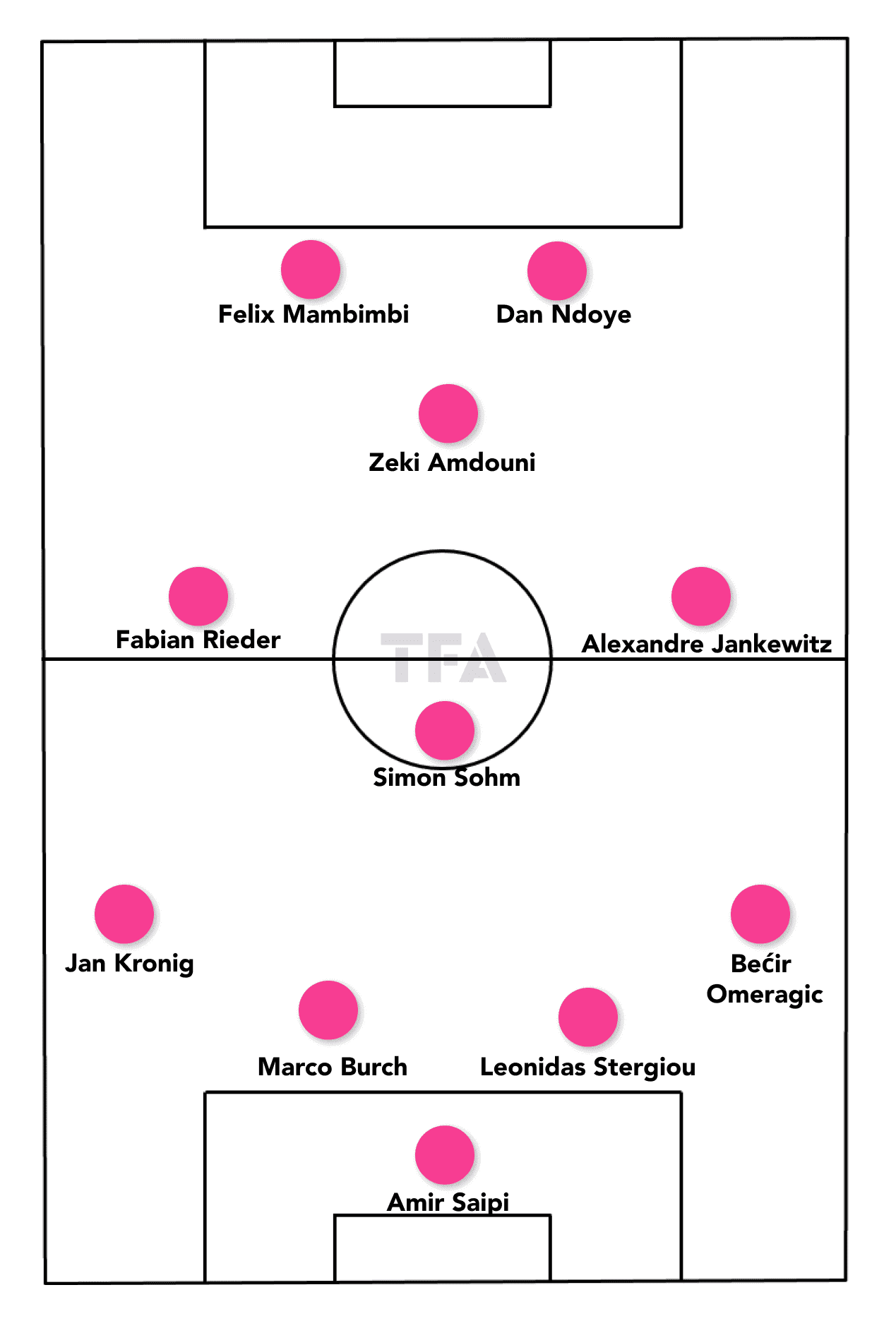
During the qualification phase, we would typically see Switzerland deploy a 4-3-1-2 shape, but, as mentioned, Rahmen looks like he hasn’t yet decided what formation he wants. In his first and only three games in charge, he has used a different shape each time — 4-4-2, 4-4-1-1, and 4-2-3-1. The first two can be similar to each other and, by extension, similar to 4-3-1-2, dependent on width. There is also the possibility that he sticks with the 4-3-1-2 and was simply experimenting with different shapes.
Let’s say that the latter is the case, their lineup will probably look something like the graphic above. Amir Sepir was a consistent figure between the sticks that conceded just six goals during qualification, so he’s a front-runner for the spot this summer. He played in Rahmen’s first game in charge but did not feature in the two that followed; both of those games saw appearances for different keepers. That kind of possibility to rotate and rely on squad depth runs throughout the team, with few players being nailed on for a definite starting spot on the regular.
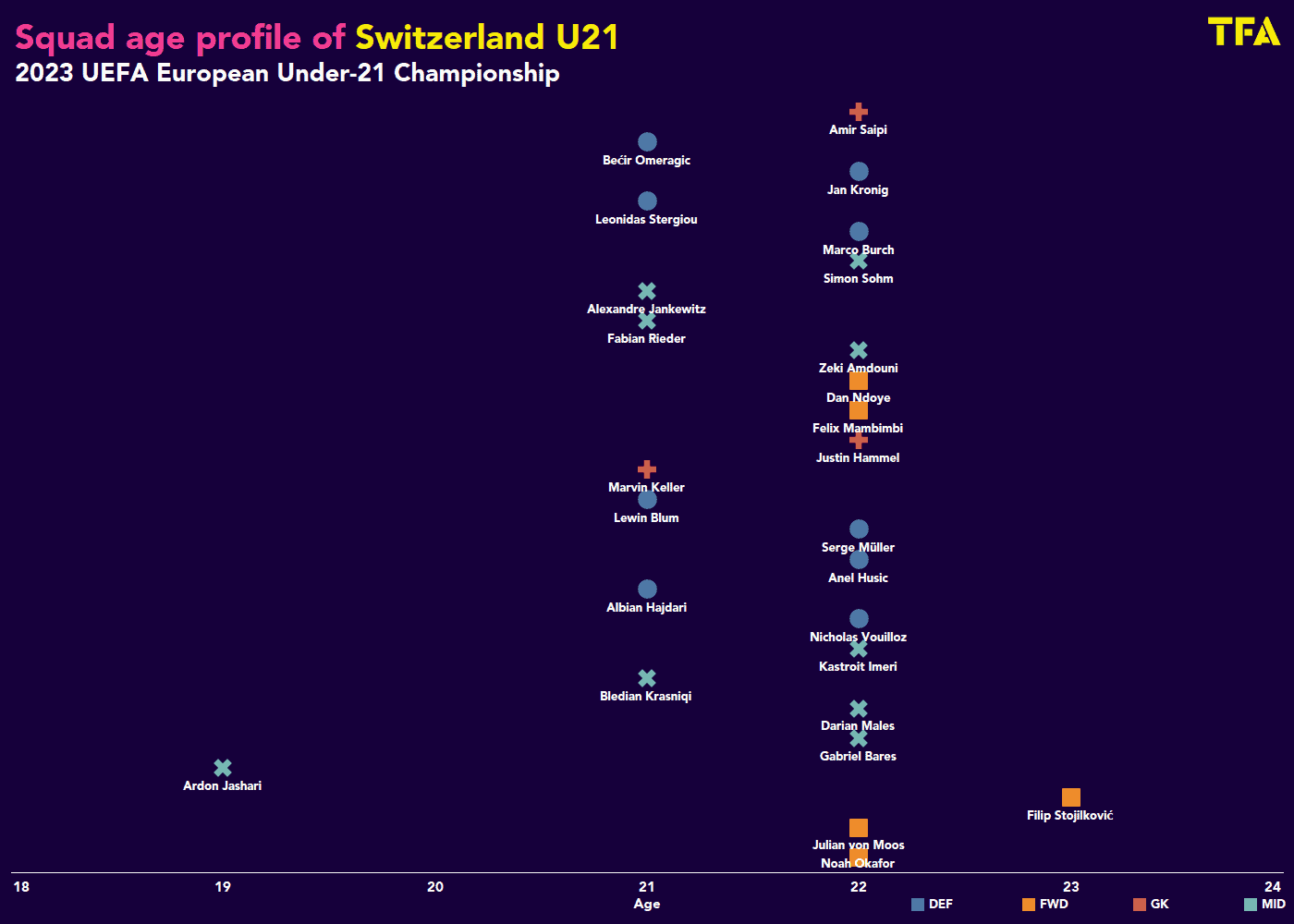
In terms of age, there is just about as much experience as you can at U21, with just one expected player under the age of 20: Ardon Jashari. Stojilković is likely to be the only player aged 23, with a good chunk of the expected squad to be aged 22. The fact that the Swiss were able to have consistency in terms of the general squad, but also rotation in the starting 11 could bode well for them, but only if they can find their form under a new manager.
Attacking phase
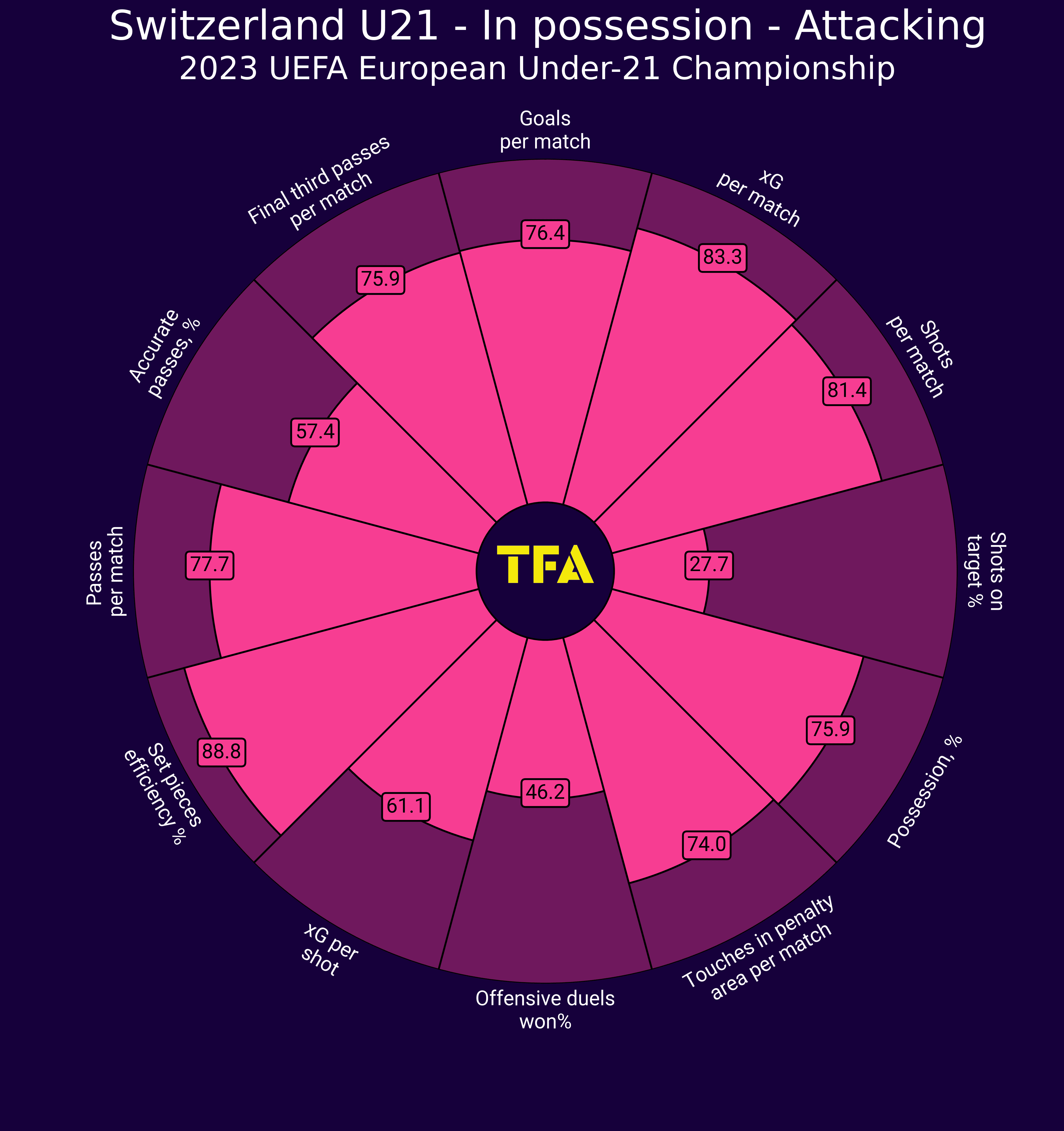
During the qualifying rounds, Switzerland showed that they like to play attacking football with a good balance and level of intensity, and as you can see from the data pizza above, they found a good level of effectiveness in possession. They ranked particularly high in xG and shots per match, indicating how effective and dangerous they are in the final third. They have also demonstrated how prolific they can be from set pieces, ranking in the 88.8th percentile during the qualifiers.
While they do experience games where they have to sacrifice the possession majority, a lot of the time they like to control the ball, ranking in the 75.9th percentile. This is matched by their high percentile ranking with passes per match — this isn’t to say that you should expect to see them playing out from the back regularly, they have a tendency to be more direct from the back, but utilise more passes in the midfield and attacking thirds.
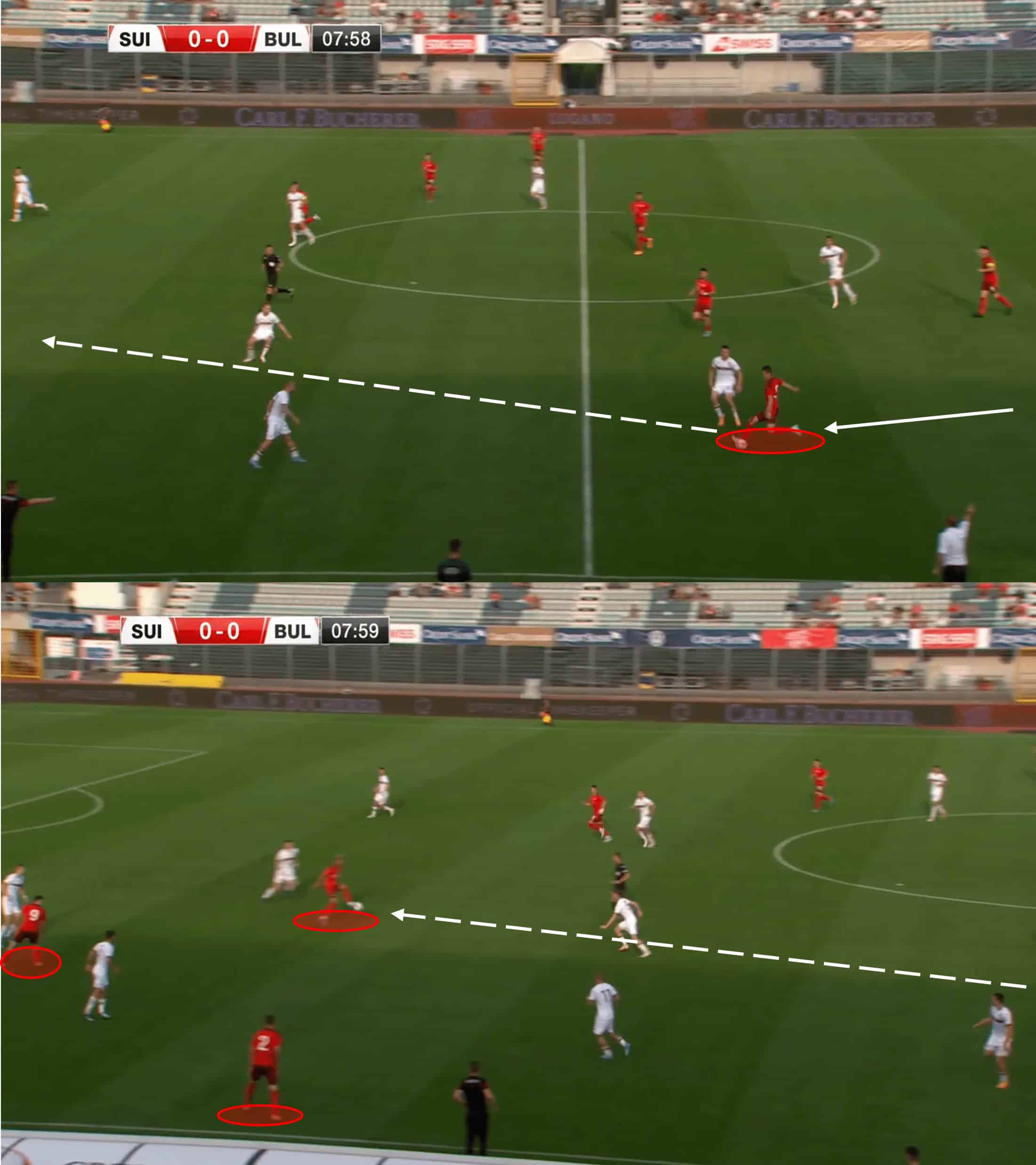
Before the arrival of Rahmen, Switzerland had a varied approach but one of the main elements of their attacking tactics was the tendency to play line-breaking passes from defence into advanced areas of midfield. This would usually be in the form of a ground pass if the ball came from central defence, with attacking support in surrounding areas for the recipient of the pass. Regular use of this method also highlighted the players’ ability to recognise space left by the opponent and how to exploit it.
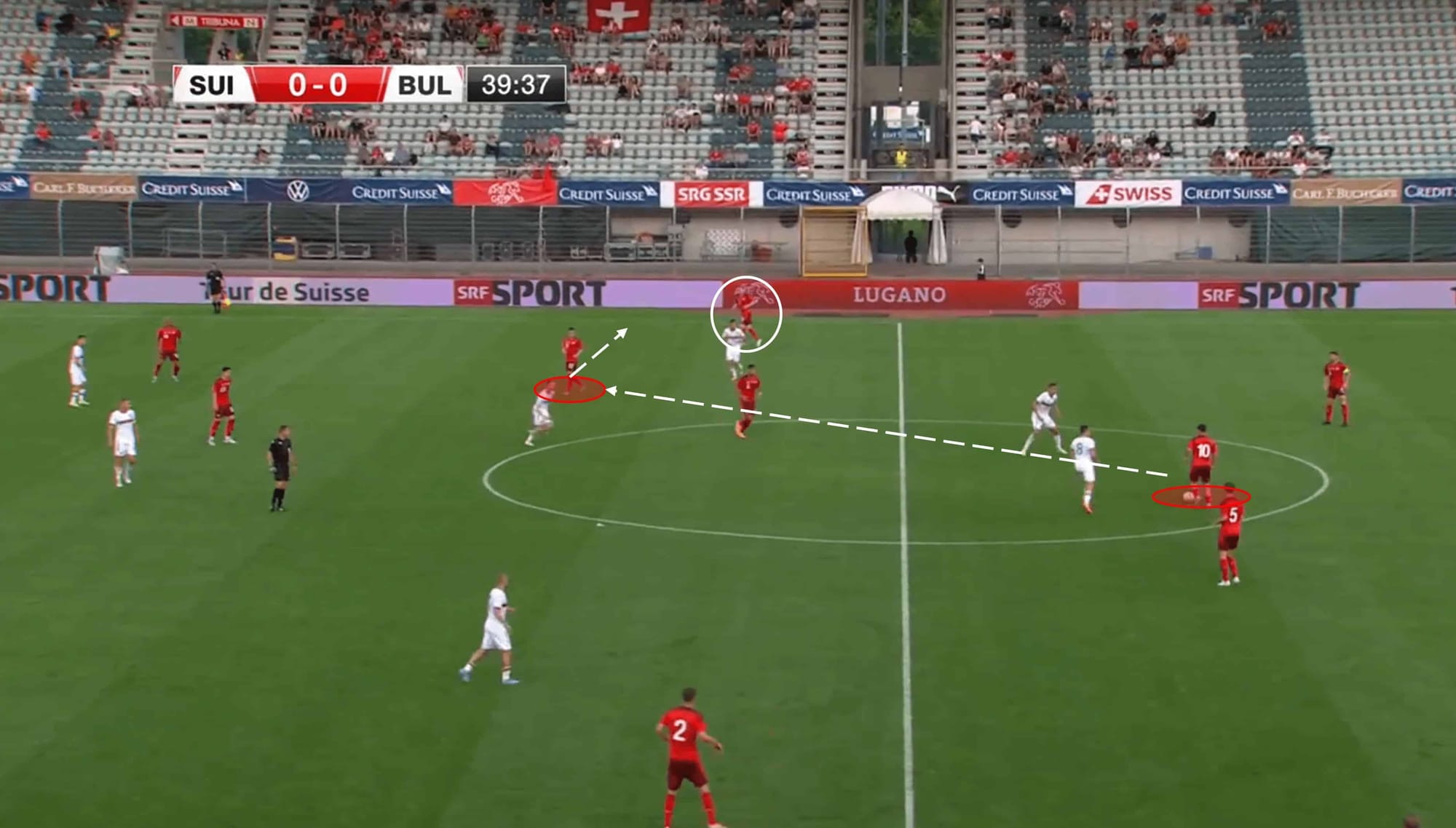
This is a similar example to the previous one, but highlights the use of positional rotations in midfield areas — you can see that the number 10, in this case, dropped into a deeper zone to play as a deep playmaker. Not only does this positioning give him a wider range of passes in front of him, but it also drags the opposition midfield out of shape, giving him the opportunity to pick up and exploit space in higher areas. As mentioned, this was a regular feature for Switzerland during the qualifiers, and it is something that we could see more of under Rahman this summer.
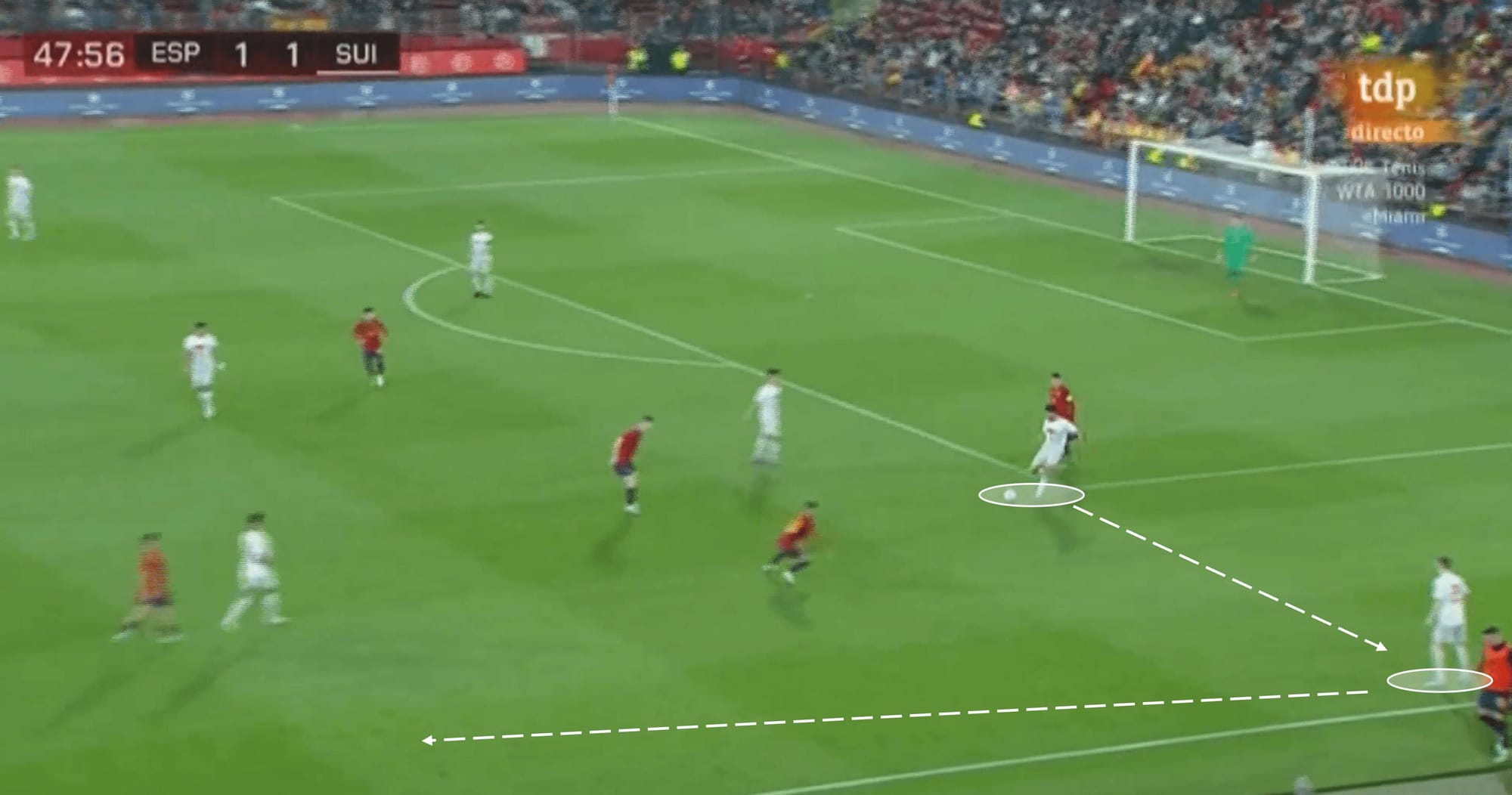
Positional sense seems to be a strong trait of this Swiss side, particularly in regard to supporting players on the ball. While they look to build attacks in a more structured way usually, they are prepared to switch things up in situations where they are under more pressure and don’t have the option to carve the opposition open via ground passes.
Take the example above, Spain have a high presence in Switzerland’s half, but rarely will you see direct balls from central areas of defence. Instead, there will usually be a supporting full-back close by who can receive the ball in a wider position, where they will send a direct ball forward when the chance presents itself — the passes either going to a centre-forward or down the flank in behind the opposition full-back.
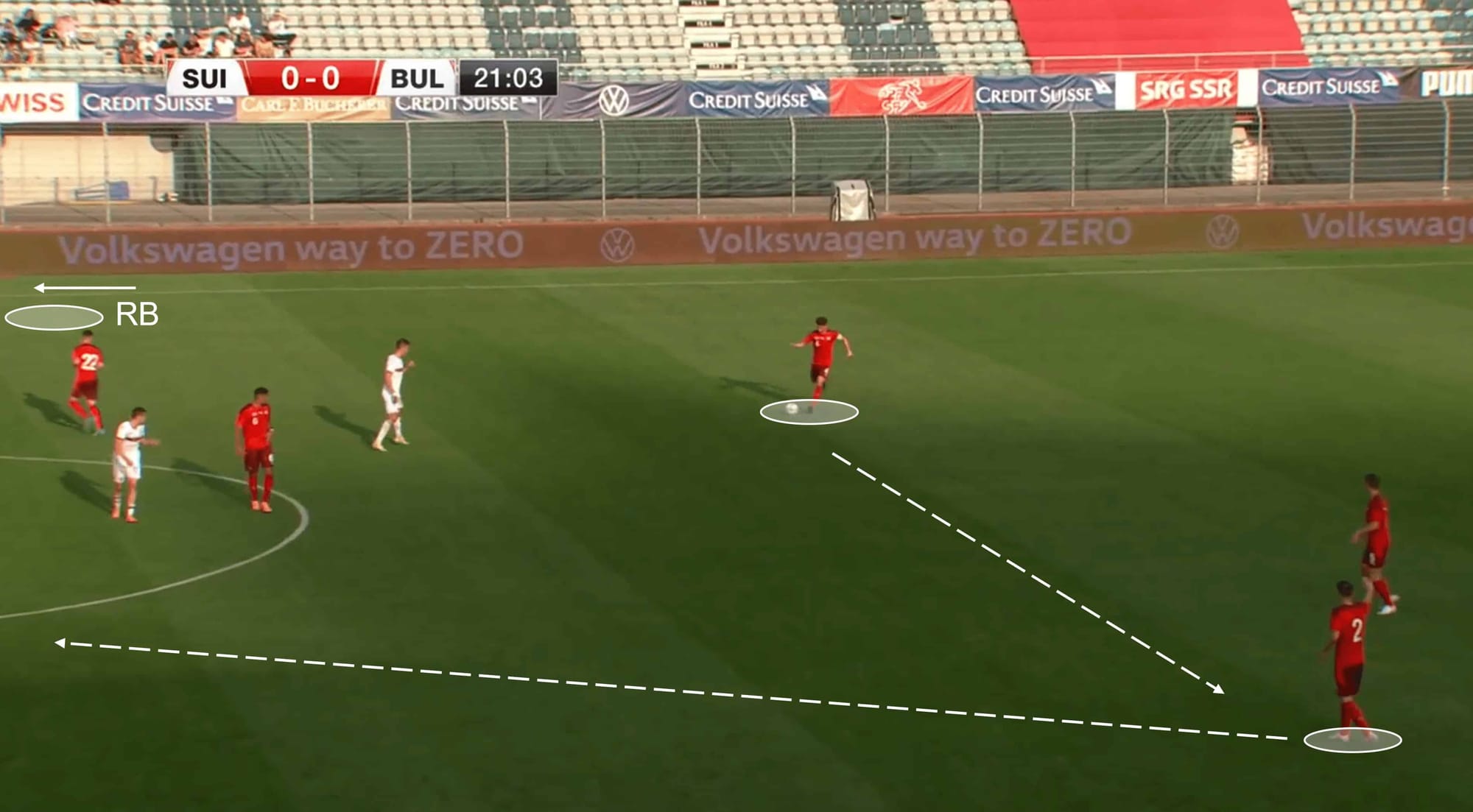
Here is another example of using the full-backs to launch attacks in build-up play, with an interesting slant on positioning. With the right-back in a much higher position than the rest of the back four, the left-back will sometimes tuck inside with the aim of sending a diagonal pass to the other flank that will be experiencing an overload. Notice the presence in nearby central areas is still there intending to draw opponents higher up the pitch, giving them more chance to use the overload to their advantage.
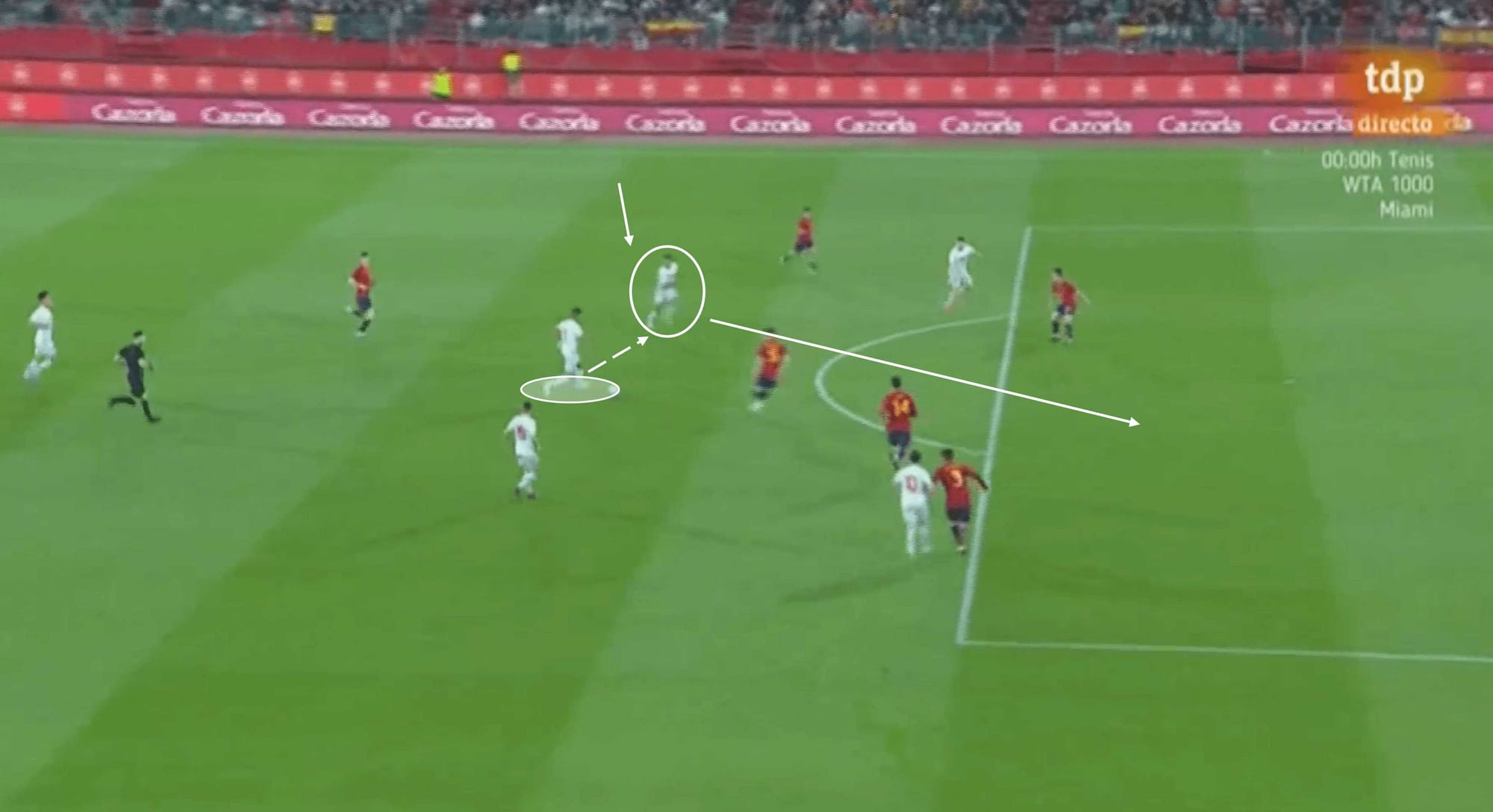
While they aren’t afraid to play in a direct way from deeper areas, once they get into the midfield/final third, we see more of a fluid approach that centres on off-the-ball movement and short passes. These bursting runs can be difficult to track, mark, and stop, just as Spain found out in this particular scenario. The player who went on to score made a defence-splitting run through the middle of Spain’s defence, with his run starting from the left flank and coming inside. Several goals the Swiss U21s have scored, both before and during Rahman’s reign, had this aspect of play, so expect to see them attacking with the same gusto in the tournament.
Defensive phase
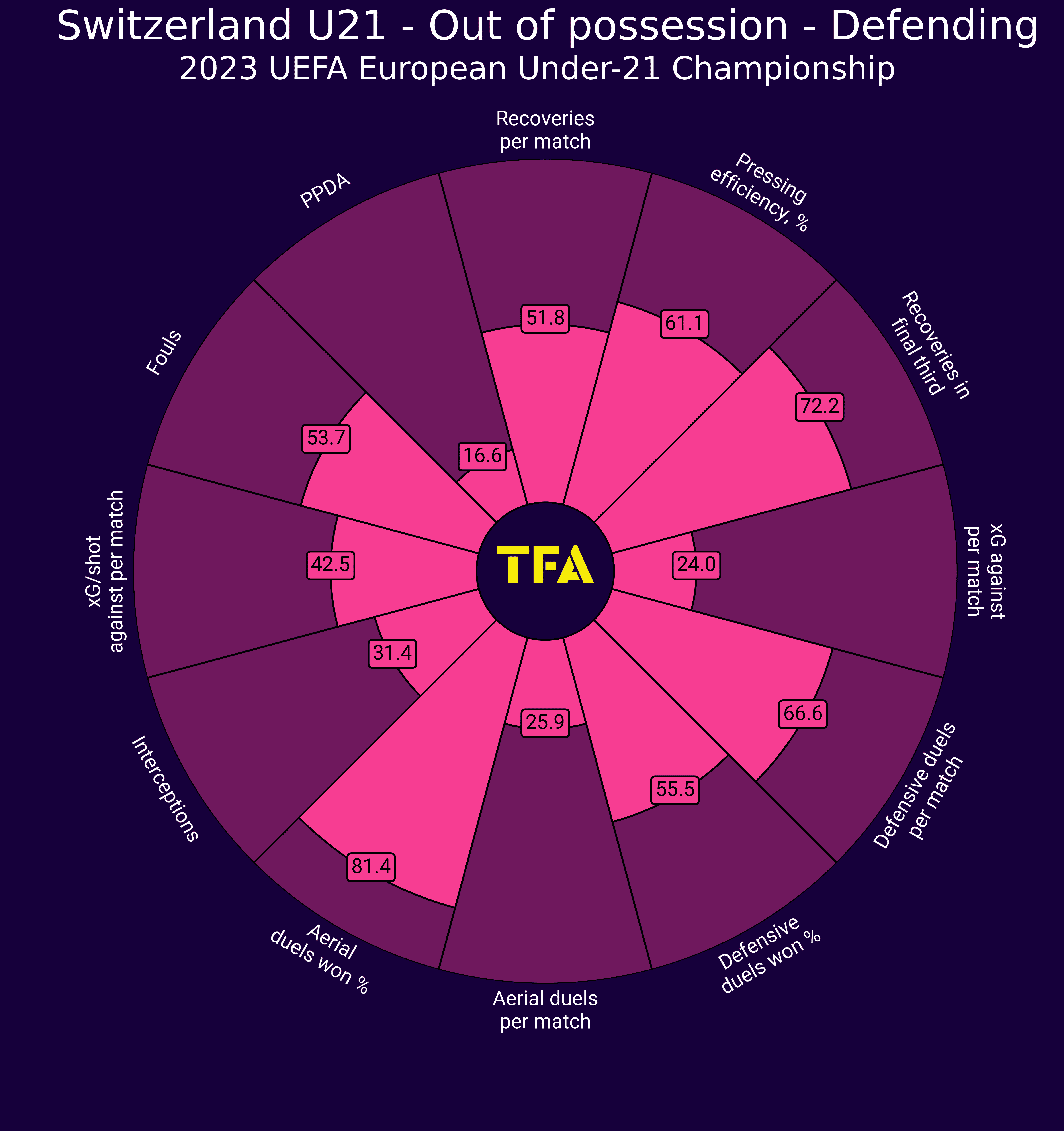
Switzerland’s physical and aerial prowess shines through in their defensive data too, as evidenced by their high percentile of aerial duels won. They do, however, show inconsistencies in success when it comes to defensive duels and recoveries, although they perform well when it comes to recoveries in the final third. The low rank in PPDA makes for good reading, as does their low percentile rank for xG against per match, showing that they had a generally good time in keeping chances out during qualifying.
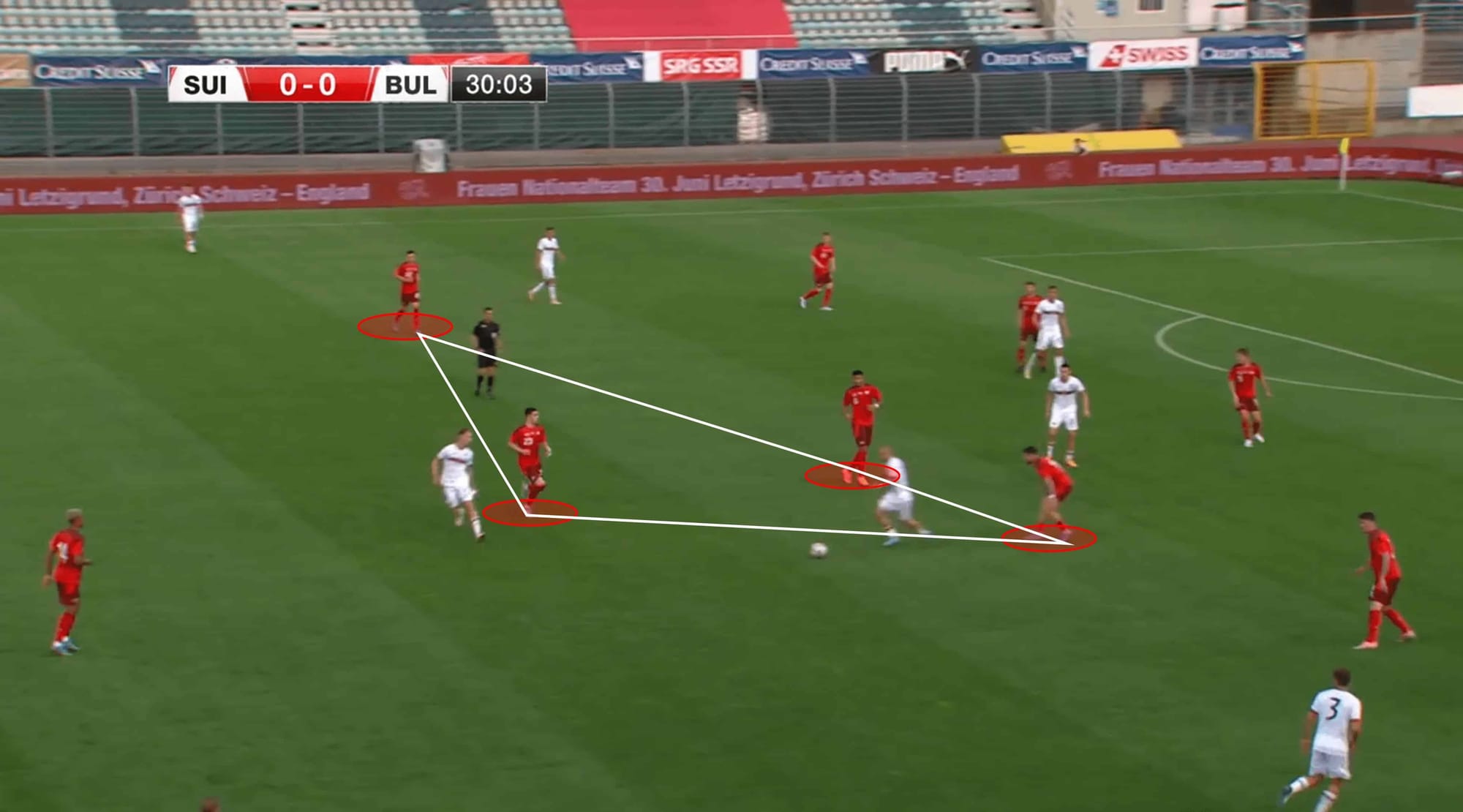
Defensive structure in midfield is something that was valued by Lustrinelli and is something that has carried through in Rahman’s reign; while the formations differ, the principles match. The example above is taken from a qualifying game last year with the Swiss playing their 4-3-1-2 formation, something we could still see from Rahman’s side, so the defensive positioning is relevant here.
The deeper three midfielders remain in line with one another, looking to block the opposition’s path through the middle. Inevitably, this can force the opponent to attack wide areas, and in response, the deeper midfield three shuffle across as one. The more advanced midfielder’s role varies out of possession. You will either see him in close distance to the deeper three to add defensive support, or they will leave that post to trigger a press in central areas.
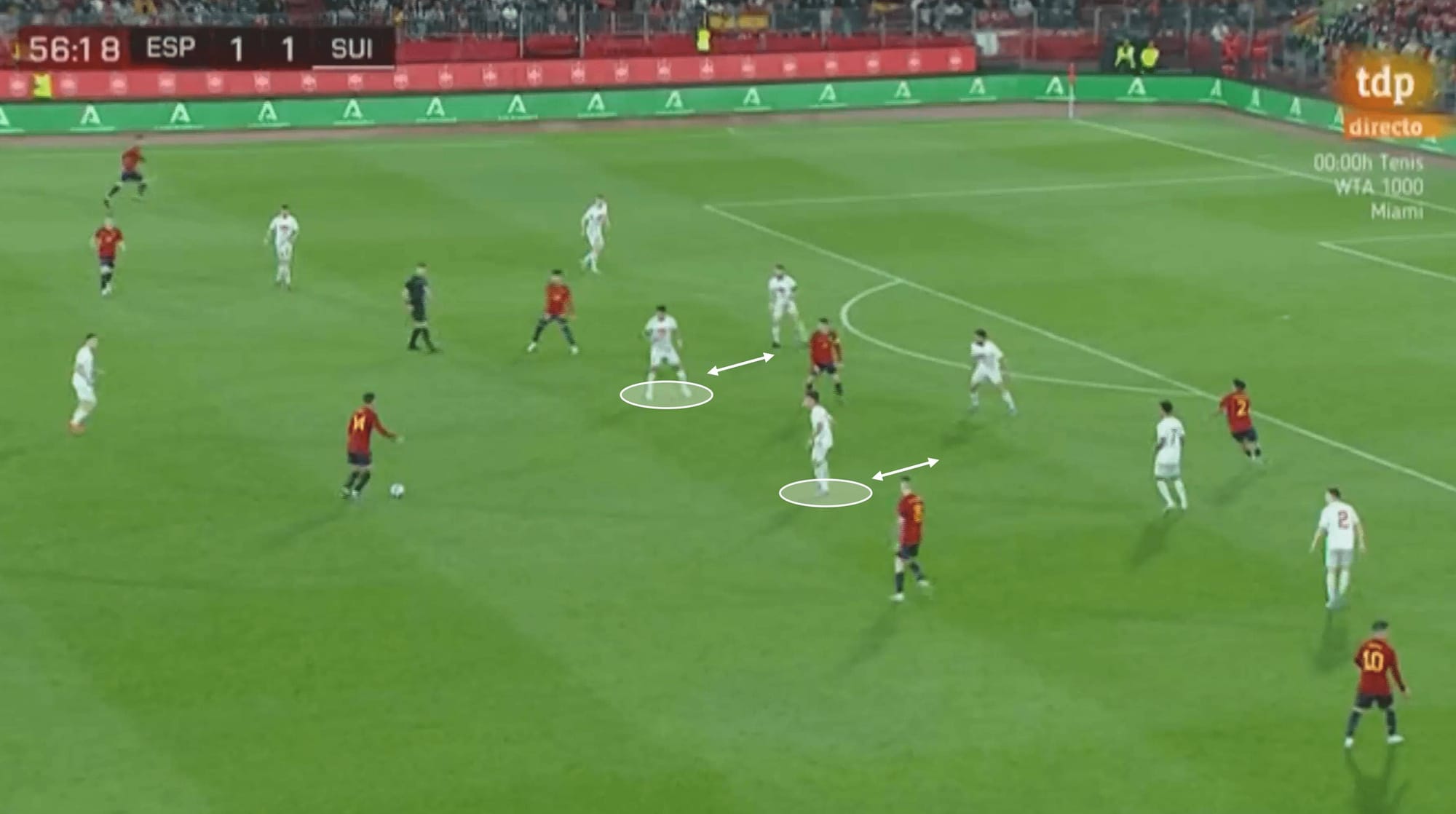
While the last example was taken from a Lustrinelli fixture, this one above is from a Rahmen match, so you can see the similarity in defensive tactics from the midfield. The central two midfielders will initially apply a press if possession comes from a turnover in the corresponding area before retreating to give the defensive unit some backing. While the depth and width may vary depending on various factors, they will likely stay close to the defenders, essentially adding another layer to the defensive wall.
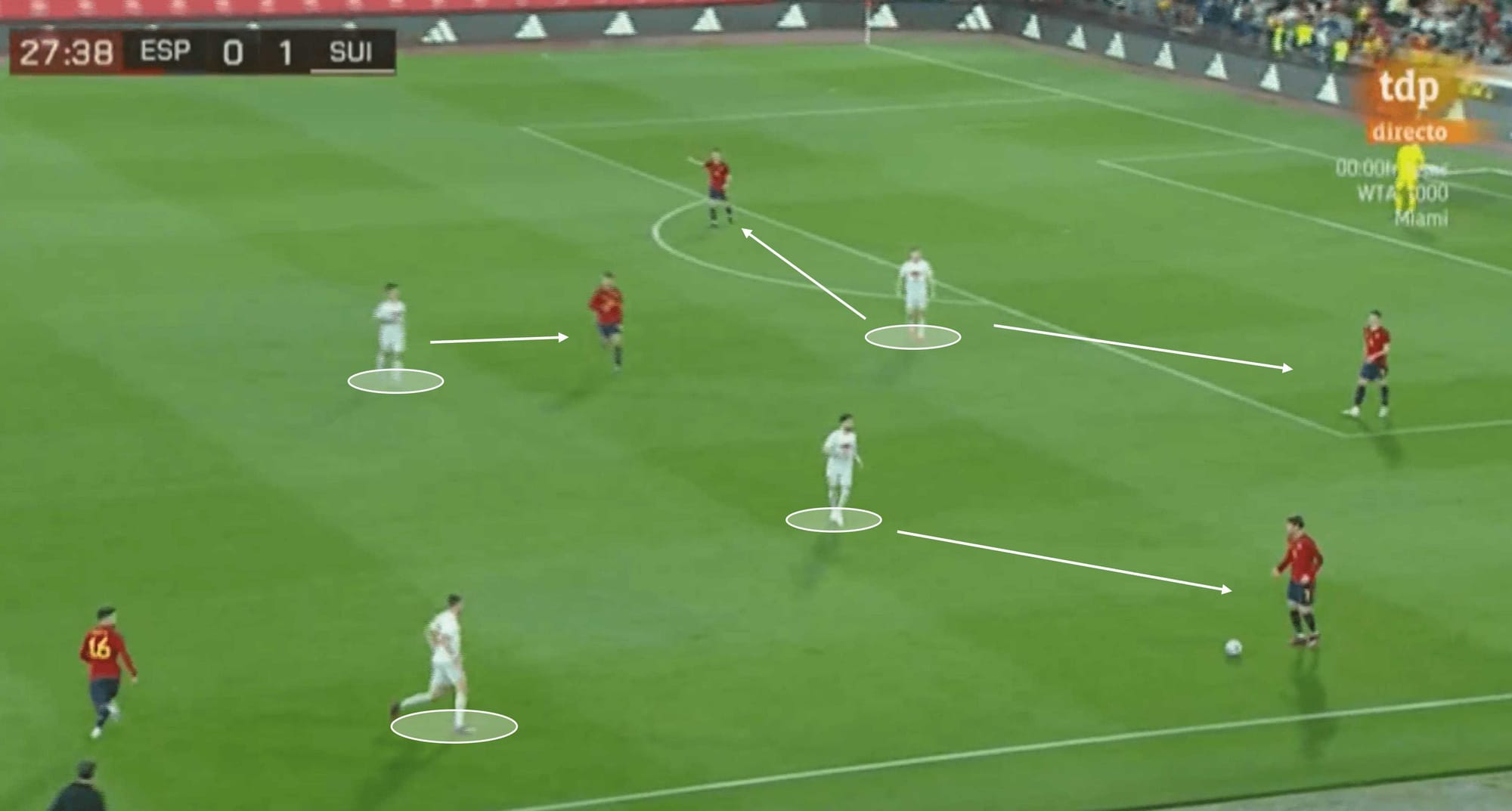
Switzerland will take the initiative to try and unsettle the opposition if they have possession deep in their own half, committing a slightly higher line and sending players forward to form a high press. While it may not reach the intensity levels that we’d see from a Jürgen Klopp-esque press, the presence and positioning is the key point that allow the Swiss to disturb the opponent’s possession. The furthest player forward looks to occupy the deepest opposition player(s), forcing them to try and play forward — other nearby options will be marked, and there will be some pressure applied to the man on the ball.
Transitions
While some teams will look to hold onto the ball in the event of a turnover to try and build up some momentum and slowly get bodies forward, Switzerland prefer to play the way they’re facing; if they steal the ball while facing the opposition goal and have teammates forward, they will look to break quickly in an aggressive and often direct manner, utilising individual dribbling and passes into space, accompanied by a burst of teammates making runs to support the counterattack.
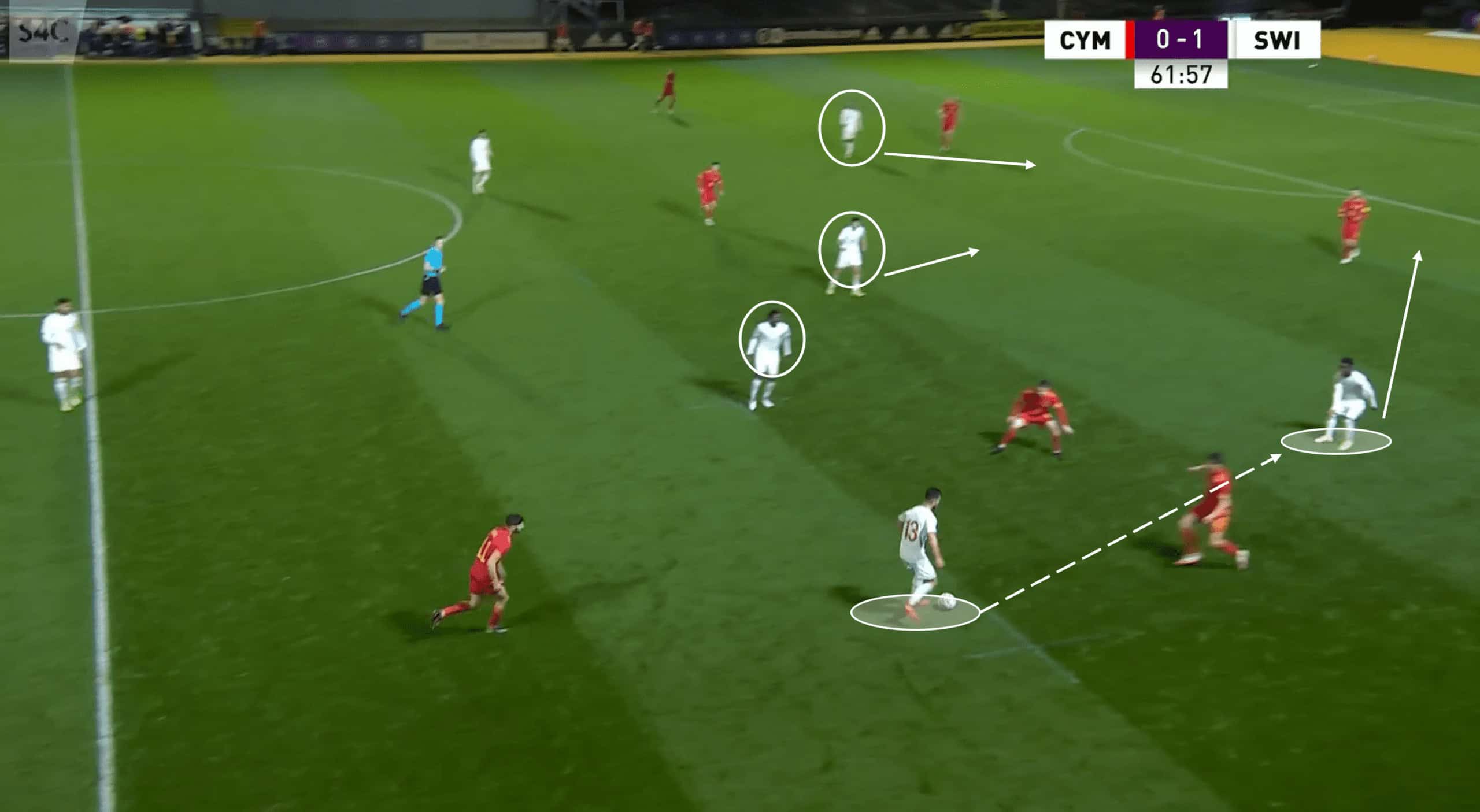
We can see that attacking mindset in the example above. Switzerland’s number 13, pictured on the ball, swooped in to steal the ball from Wales’ number 11 near the halfway line and used his momentum and the high positioning of his teammates to instigate a powerful attack in transition. A quick forward pass into an open teammate, matched by forward runs in varying areas in the final third made the Swiss a danger in these moments of transition.
In terms of defensive transitions, we may see them apply initial pressure to halt an immediate counterattack from the opposition, before regrouping to form a strong shape, particularly the midfield, as discussed prior. However, losing the ball in attacking areas will result in a counterpress with more intent than in deeper zones, looking to force an error from the opposition in a potentially dangerous area.
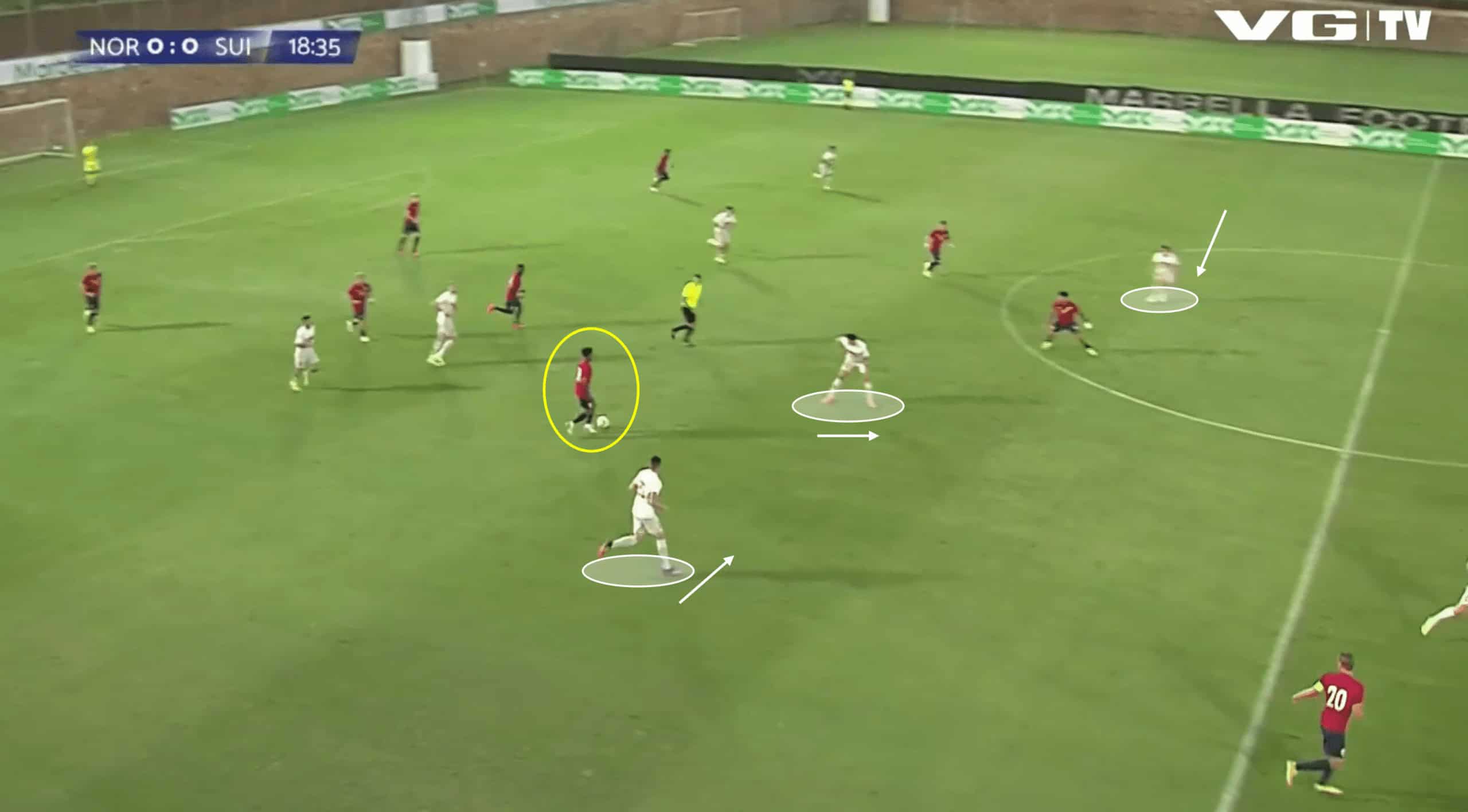
We see these elements in the image above. Norway won possession slightly deeper than where they have it in the image, with the midfielder looking to push forward. Initially, the centre figure of the three highlighted Swiss players motioned as if he was going to swarm the man on the ball, but thought better of it and began retreating to a deeper position that encouraged defensive reinforcement. The two wider highlighted players tucked inside from wider areas to provide some compact stability — while the execution on this occasion was flawed, the principles remain the same in terms of what Switzerland look to achieve in a defensive transition.
Defenders
Captain Leonidas Stergiou is almost certain to start at the heart of the back four, likely alongside Jan Kronig, although Nicolas Vouilloz has featured in all three of Rahmen’s friendlies so there is the possibility of him providing strong competition. At right-back, it looks as though Bećir Omeragic will be the primary choice, with Serge Müller waiting as a backup. Left-back is another position that Rahmen has used multiple options for so far, but Marco Burch looks the likeliest option as he was a consistent presence during qualifying and has made appearances from the bench under Rahmen. Backup options in that position are likely to come in the form of Albian Hajdari and Lewin Blum.
Midfielders
In midfield, the two most central players are likely to start, even in a 4-2-3-1 or 4-4-1-1 — Simon Sohm playing in the deeper role and Zeki Amdouni in the more advanced position, although he could be a possibility up front as well. Alexandre Jankewitz and Fabian Rieder were both consistent figures during qualification, but they have the element of squad depth in midfield generally, with players such as Kastriot Imeri, Darian Males, and Ardon Jashari also likely to be in the squad.
Attackers
The Swiss have had the tendency to rotate up front, utilising a range of options in the squad like Filip Stojilković, Julian von Moos, and Noah Okafor — the latter of whom has had recent involvement in Switzerland’s senior squad. The likely starting strikers in a two-man striker formation would be Dan Ndoye and Felix Mambimbi, both of whom have the element of versatility in terms of positions as they can play on the wing or as a number 10.
Key player
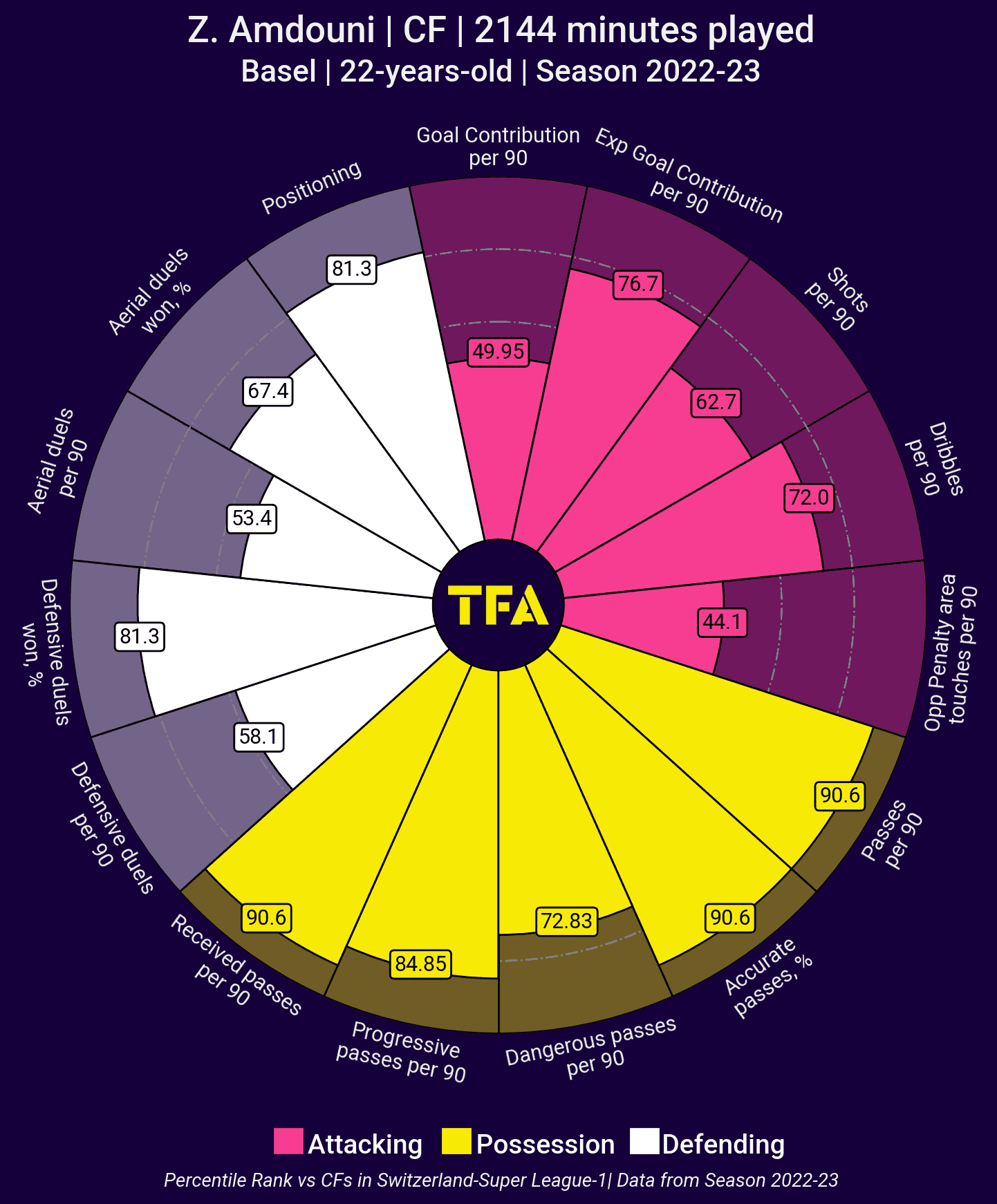
Able to play as an attacking midfielder, winger on either flank or as a centre-forward, Zeki Amdouni could be the key Switzerland figure this summer, especially in an attacking sense. In qualifying, he scored seven goals, putting him in the group of third-highest scorers in the qualifying phase. The young Basel player is showing promising signs at club level too, with 12 g/a in 30 games this season — if he performs well, Switzerland will be a dangerous team.
Looking at his data, in comparison to other forwards in the Swiss Super League, he shines in several areas. He gets heavily involved in the build-up, as evidenced by his high percentile ranks for metrics like passes per 90, progressive passes per 90 and dangerous passes per 90, and he also adds a threat in the final third. Good percentiles in expected goal contributions per 90 and dribbles per 90 also highlight the different areas in which he can be effective.
Tournament prediction
While Switzerland were one of the strongest teams in qualifying, they will have to be at their absolute best in the group stage as they have been pitted against France, Italy, and Norway — something of a group of death really. Getting out of that group will be extremely difficult, but not impossible.
If they achieved this, it will fuel them to go further, with teams likely showing them more respect based on getting out of such a challenging group. The top two from each group progress to the knockouts, and if they tick that one off, who’s to say they won’t go as far as the semi-finals? The only thing that may hinder their potential in this competition is that they have had little time to work on the new manager’s tactics, so they may still be in an adjustment period.

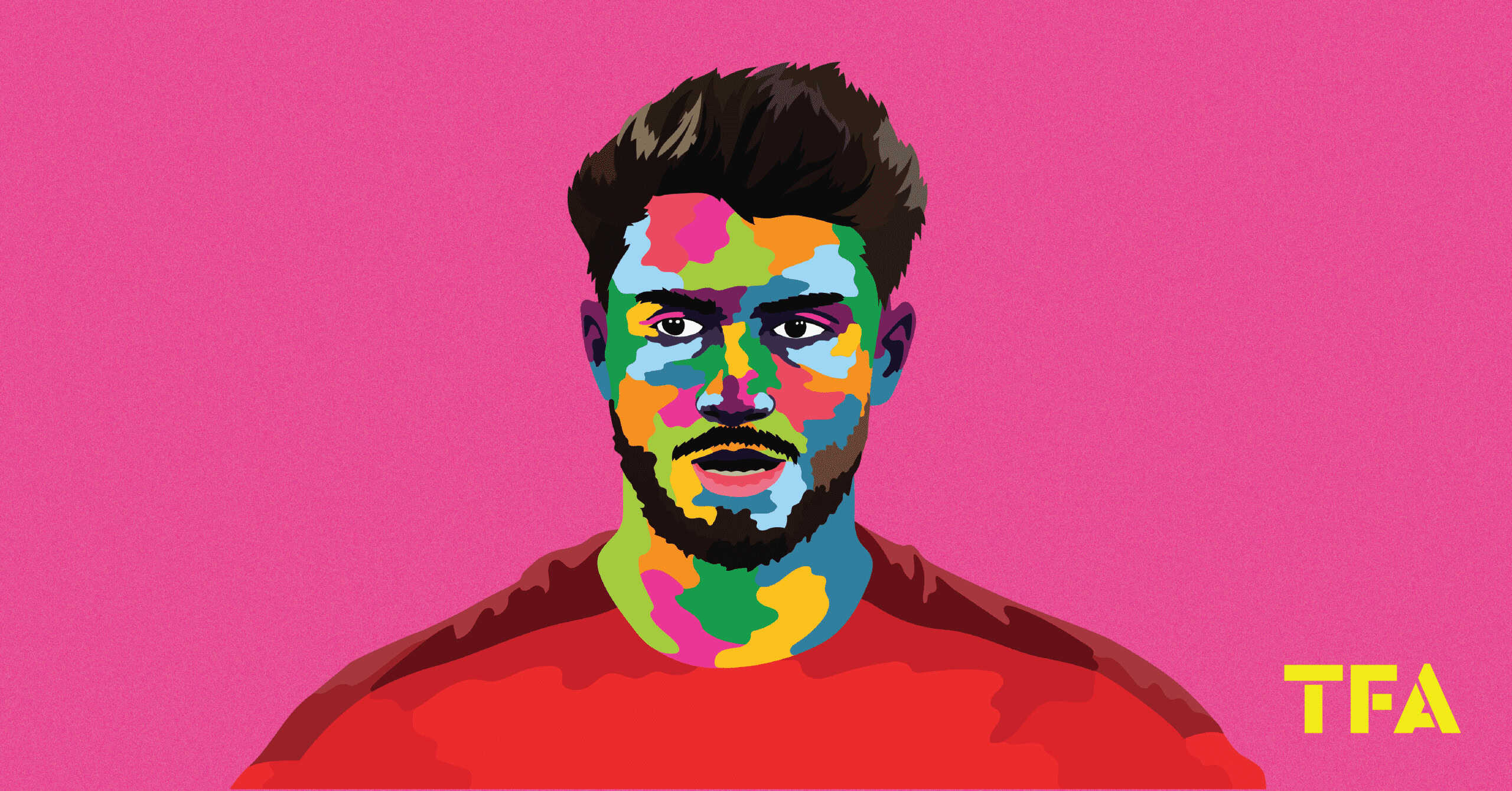




Comments